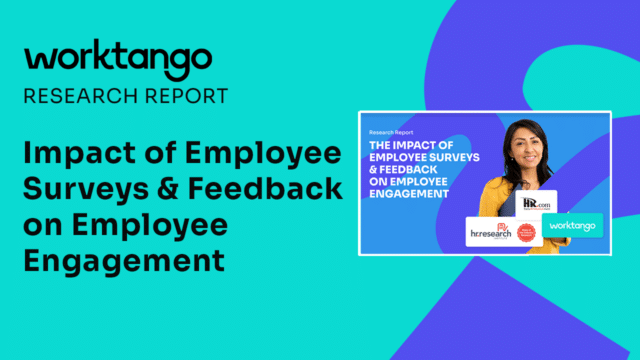Many of us looked to 2021 to bring something better than the previous year – and in many ways, it did. The economy rebounded more quickly than expected, people found jobs again, and many companies grew by large margins.
Additionally, many businesses began returning to the office — at least in part — which brought feelings of normalcy. But 2021 brought its own tumultuous shock: The Great Resignation.
In the U.S., workers have been leaving their jobs in record numbers since April, most citing the search for a better quality of life.
With this in mind, as we head into 2022, company leaders are focused on creating a compelling employee experience and nurturing company culture — especially in a hybrid work environment.
Top Workplace Challenges of 2022
In November 2021, we surveyed hundreds of HR leaders across the globe to find out what changed over the last twelve months, and how they’re problem-solving for 2022.
Looking back
There are some clear differences between this year and last year when it comes to what companies are planning to focus on in the year ahead.
Looking forward
When thinking ahead to 2022, the following topped the list of key initiatives among our survey respondents:
The overarching trend? It’s all about employee well-being.
Digging deeper — What led to the shifts in retention, morale, and company culture?
Work has become busier
As we gradually emerged from lockdown this year, consumers tried to make up for lost time with phenomena like “revenge shopping” and “dine-in rebound.” Paired with a healthy return to leisure travel, nearly half of our respondents saw increases to both their revenue and customer base.
In our study:
- 47% of respondents saw increases in revenue and/or customers in 2021
- 37% reported that business was level compared to 2020
- 16% saw a decrease in revenue or customers
For many organizations, the boom in business meant an increased workload. With significant numbers of employees now leaving their jobs, those who remained felt the pressure from both ends. Jarring shifts in output and expectations always have the potential to flatten employee morale. When workers become disillusioned and burned out, resignations spiked even further.
Remote employees are returning to the office (with some caveats)
During the pandemic, an overwhelming majority of organizations pivoted to some level of remote work. Now they’re coming back — but gradually, and often with plans for a future that includes hybrid work.
In our study:
- 84% of companies surveyed shifted to remote work (before or during the pandemic)
- In 2021, 86% of those businesses who intended to return to the office began the process
Many workers want to continue working remotely, at least part-time. As a result, organizations are scrambling for ways to strengthen a company culture that’s different than it was before. They want to create belonging and foster inclusion – especially for diverse talent – within a hybrid workforce and in an age where psychological safety is particularly threatened.
The Great Resignation made employee retention an urgent business matter
One in four American workers quit their jobs in 2021, with over 4 million leaving in August alone. The rise in resignations has created unprecedented challenges for talent acquisition professionals, managers, and teams scrambling to fill in the gaps.
When positions stay open longer, fatigue sets in for those picking up the slack, which can lead to an erosion of morale, a potentially toxic workplace culture, and even more resignations.
In our study:
- 53% of respondents experienced an increased employee quit rate this year
- 54% encountered a longer-than-usual hiring process
- 49% saw stronger-than-usual competition for top candidates
Building your action plan
So, what can we do to prioritize thriving workplaces in 2022? Keep reading for actionable advice on how to make work a place people actually want to be. In this report, we’ll highlight the following 4 key initiatives:
Initiative 1 — Boost the employee experience with recognition and growth opportunities
The employee experience in 2022
With people spending most of their waking hours at work, they want to be part of a healthy culture where they feel recognized, supported, and have opportunities for growth. In short, they’re looking for a positive employee experience.
And, with the Great Resignation in full swing, companies need to focus on the employee experience to ensure their business can thrive.
Our 2021 research revealed that employee experience is only a mid-level priority for most companies and it’s way past time to bump it to the top of the priority list.
In fact, research shows that employee experience is the factor driving employee retention.
Gain a retention advantage with recognition
When it comes to efforts to increase retention, our2021 survey revealed that 3 out of 5 businesses relied heavily on increased financial compensation. However, recent research shows that employees are actually seeking relational investment more than financial incentives.
Our data reveals that only about 30% of respondents are leaning into improved recognition and rewards. Companies who make that a priority stand to gain a huge advantage over the competition.
In our study, companies looked to keep top talent by:
- Increasing compensation (56%)
- Flexible scheduling & remote work options (49%)
- Improved benefits & perks (39%)
Why recognition matters
When it comes to recognition, 63% of those who are “always” or “usually” recognized say they’re “highly unlikely” to leave their jobs in the next 3-6 months, while a lack of recognition is consistently cited by employees as the #1 reason for leaving their jobs.
Recognition is absolutely key to building a connected, committed workforce. It improves satisfaction and happiness, fosters a sense of camaraderie, communicates to workers that their contributions are highly valued, and makes the difference in employee retention.
Companies with effective recognition programs register a 31% lower turnover rate.
Helping your employees grow
Top performers want to grow into the best version of themselves. In fact, when choosing between similar jobs, 60% will opt for the one with stronger professional development.
They’re looking for an organization and a manager who will value their personal career goals, help them define and develop their skills, and care deeply about their potential as a team member. Employees whose managers serve as coaches and partners rather than standard “bosses” are happier, more engaged, and more likely to stick around.
Only 34% of companies surveyed are using data for employee growth opportunities.
Why growth matters
When work feels like a dead-end, your employees can get frustrated and feel unfulfilled with their work. Their engagement starts to decline, they check out, and begin searching for more exciting opportunities elsewhere.
To keep top talent, your team needs a chance to develop new skills and take on new challenges. They need to see that you’re willing to nurture, prioritize, and invest in their personal career advancement.
In short, great workers who aren’t allowed to grow, will go.
58% say their company doesn’t offer sufficient growth opportunities to make them stay.
Initiative 1 takeaway
- Make employee recognition peer-to-peer. For many employees, their peers see more of their daily contributions, giving them more opportunities to get a pat on the back from someone who truly understands their work. Recognition from peers can feel more authentic than top-down recognition, which sometimes comes across as obligatory.
- Give employee recognition in real time. Just like feedback, recognition is always better to give while the subject is still fresh on your mind. Giving timely recognition ensures that good work doesn’t get lost on a to-do list and makes a clear connection in the recipient’s mind between the outcome and their behavior.
- Offer learning and development opportunities. As we mentioned, access to growth opportunities is the fastest-growing reason people leave jobs. But growth doesn’t always have to be a promotion. Many employees consider a lateral move just as valuable as an upward one. When given opportunities to develop new skills, quality employees jump at the chance.
Initiative 2 —Build a cohesive hybrid workplace where people feel included and connected
No office, no problem
It’s been a long time coming, and the pandemic drove it home: The future of work is hybrid. Location-agnostic positions are now an expectation rather than an alluring exception. In a recent study of those who recently accepted jobs in a new city, 90% were not required to relocate.
The research is clear – the majority of workers prefer hybrid or remote work, and they are willing to make big changes in order to attain it. In fact:
- 74% of CFOs expect to shift some portion of their workforce to remote work permanently
- 50% of people say they won’t return to jobs that don’t offer some level of remote work
- 75% of people were equally or more productive when working from home during the pandemic
Creating a culture that’s geared toward helping remote and hybrid workers thrive is absolutely essential to the future of your organization. And the more location-agnostic jobs you offer, the more likely you are to fill them with top performers.
Keeping people connected
If the future of work is hybrid, what does that mean for our sense of connection and belonging? Connection is more than seeing someone in the office or having a conversation around the water cooler. Connection contributes significantly to an employee’s overall sense of happiness, their desire to be productive, and helps them maintain a high level of engagement in their work.
When people feel connected to their colleagues, their managers, and their company, they feel engaged, productive, and have a positive employee experience. Employees with a deep sense of belonging take 75% fewer sick days — that’s a win-win for everyone.
More than 1/3 of workers want to leave their job because they don’t feel they fit in.
How to increase connection
A recent survey noted that 40% of U.S. workers feel emotionally and physically isolated at work. Now, let’s be frank — it can be hard to create connections in a hybrid work environment, but it’s not impossible.
If you’re looking to increase connection at your company, start by creating a culture where expressions of care are modeled and encouraged, especially in the manager/employee relationship. Encourage managers to build a sense of continuity with their direct reports by checking in with them regularly and reminding them of how their unique contribution is making an impact.
When employees are connected both to people and purpose, there’s potential for real belonging.
39% of people say they feel the strongest sense of belonging when co-workers simply check in on them.
Making people feel included
Building a culture of connection and inclusion takes work and intention – especially in a hybrid setting. Making sure all workers — especially those who bring diversity to our teams — experience true belonging and psychological safety is critical to overall business success.
While diverse workers add unmatched value in perspective, many don’t experience meaningful connections at work. As a result, they’re more likely to leave. Black workers are 30% more likely to leave than their white counterparts with one in three saying they’re planning to leave in the next two years. In large part, this is due to decreased feelings of personal safety and belonging.
How to support inclusion in your workplace
There are many inroads for taking action, but the wisest plan is to start with listening.
Consider:
- Surveying employees on psychological safety, feelings of inclusion, and connection
- Assembling employee listening groups conducted by trained HR professionals
- Ensuring diversity at each level of leadership; more diversity means better perspective and deeper insight
Start:
- Celebrating a diverse set of holidays
- Including pronouns and inclusive language
- Implementing hiring practices that reduce bias (think removing names from resumes and including skills tests)
Once you have clear takeaways, act on what you discover. Employees are watching for change.
Initiative 2 takeaway
The future of work is hybrid, and the employers who learn how to create connection, belonging, and inclusion are the ones who win the war for talent. Here’s what to do now:
- Communicate often with employees about their needs, expectations, desires, and experiences.
- Offer schedule flexibility
- Create opportunities for workers to interact naturally
- Keep communication constantly flowing in a variety of formats
- Express gratitude continuously. Workers who see that their contributions are valued are more likely to feel connected to their organizations.
Initiative 3 — Nurture employee and manager well-being to prevent burnout before it starts
Employee burnout is one of the top workplace challenges companies are facing post-pandemic. While job burnout isn’t new, the scale and intensity of burnout facing the workforce today is unprecedented. Currently, 54% of American workers are in a state of burnout and 550 million work days are lost as a result.
What is burnout?
According to the Mayo Clinic, “Job burnout is a special type of work-related stress — a state of physical or emotional exhaustion that also involves a sense of reduced accomplishment and loss of personal identity.”
What causes burnout?
The problem is typically with the organization’s practices – not the employee. Factors that drive employees to burnout include: unreasonable demands, lack of autonomy/control for workers, value conflicts, a toxic work environment, systemic unfairness, and inadequate levels of reward/recognition.
The state of employee well-being
39% of HR leaders responding to the 2021 survey said employee wellness was a challenge for their company over the past year.
In the new hybrid workplace, companies need to address existing burnout, and proactively provide mental and emotional health support for teams to create a resilient organization.
In today’s talent climate, feeling cared for is table stakes for the average employee. Workplaces that don’t offer competitive well-being perks and benefits will continue to struggle with attrition in 2022. Offering these perks and benefits promotes strongly increased morale and greater connection to the company.
Why employee well-being matters
During the long pandemic months, many workers reevaluated their personal priorities. Issues of work-life balance, mental and emotional health, social connectedness, and potential for personal growth emerged at the top of the list.
In 2021, workers rapidly fled organizations that didn’t support their well-being according to those categories. For workplaces to be competitive in 2022, employee care must be a primary point of conversation. In fact:
- 78% of workers believe their workplace should help them become “net better-off” (whole person thriving)
- 60% of employees say mental health benefits will influence their next choice of a job
Why manager well-being matters
Research shows that as the manager goes, so goes their team. And today, managers are at an increased risk of burnout as the Great Resignation continues.
They’re learning to manage remote teams, navigate employee wellness and mental health challenges, bridge the gaps left by resigning team members, and onboard replacements.
The bad news? 45% of employees say their manager seems burned out.
The good news? It doesn’t have to be that way.
How to support manager well-being
We know managers are at an increased risk of burnout with 59% saying they feel overworked. Since managers are critical to the employee experience at your organization, making sure they’re taken care of should be a top priority.
In our study, 67% of companies offered increased training and resources for managers to help them navigate the past year. This is a great start!
To help managers navigate the new hybrid workplace, all organizations should look to offer better resources – especially for new managers – like modeling or mentoring opportunities, seminars and learning & development, or providing help in soliciting feedback from their reports.
Initiative 3 takeaway
- Demonstrate to employees that you value them as whole people. Many workers left what they felt were merely transactional jobs in 2021 for workplaces that offered them a sense of care, connection, and understanding. Think of how your company can start to look after your employees by offering the care they crave.
- Offer flexible scheduling. Hybrid work is the name of the game. Find ways to offer flexible schedules that allow employees to integrate their work into the rest of their lives. Flexible schedules are a valuable perk and a retention-saver in this competitive talent market.
- Offer benefits that meet the needs of employees. Benefits are more than just medical and dental care. Companies that truly care for their employees’ well-being are offering benefits in a number of categories such as physical health, emotional and mental health, financial health, career pathing, and social connection.
Initiative 4 — Lean on employee success to boost business success
The future of performance management
Our research revealed a key differentiator between companies that experienced greater business success in 2021 versus their contemporaries who experienced the same or less business success — an approach to continuous goals and feedback that prioritizes employee success.
Companies who train managers to be coaches, who lean into the success of their team members by continuously helping to align their goals with company goals, stand to gain a huge edge in 2022.
What is a continuous goals and feedback conversation?
If your organization still does performance reviews annually, you’re not setting employees up for their utmost success .
Instead, revisit goals and feedback continuously throughout the year. The concept behind continuous goals and feedback conversations is based on the simple idea that work happens year-round — which means goal alignment and feedback should, too.
A continuous approach brings three important qualities to the process that are lacking in traditional approaches: it’s ongoing, timely, and multi-directional.
- Goals are set and tracked year-round
- Managers and employees meet weekly to discuss progress and blockers
- Feedback and recognition are given when they count — in the moment
The business impact of continuous goals and feedback
In our study, 51% of respondents who reported greater business success in 2021 use “a more continuous performance management approach, with regular 1-on-1 Sync-Ups and quarterly Check-Ins.” On the flip side, 56% with an annual or “no real” process saw decreased or flat business gains in 2021. Additionally, 42% of successful companies invested in training their manager and 58% of less successful companies increased compensation, but made no changes to their management practices
So what does all this mean? Continuous goals and feedback sets your company apart as one that sees the value in ongoing relationships, and invests in employee growth and development. It makes the difference when it comes to building connections with workers, monitoring and nurturing their well-being, managing performance in a hybrid workplace, and ensuring an optimized, individualized employee experience.
Initiative 4 takeaway
- Establish a policy of weekly 1-on-1 Sync-Ups between managers and employees. This casual yet productive conversation holds space for real-time goal-tracking, feedback, and relationship-nurturing.
- Shift from annual to quarterly performance Check-Ins. Although 1-on-1 Sync-Ups happen on a weekly basis, it’s still important to take a high-level look each quarter. During quarterly Check-Ins, managers and employees review key takeaways from their weekly 1-on-1 Sync-Ups , assess employee growth over time, and identify development opportunities.
- Institute quarterly goal cycles. When goals are set in shorter bursts, they’re less likely to be forgotten. Shorter-term goals tend to be more realistic, supply opportunities to celebrate incremental wins, and allow managers to navigate challenges as they appear and not employee progress as it unfolds.
Going forward
There’s great hope that 2022 will be a year in which companies prioritize the employee experience, and as a result, start to thrive more than ever before. Those that nimbly meet the needs of their team (managers included) are sure to attract top performers and retain them.
Those who prioritize the following will see remarkable results by this time next year:
- Supporting employee well-being
- Fostering connection, belonging, and true inclusion
- Encouraging empathetic, continuous performance management
- Building a company culture that embraces the dynamics of the hybrid work model
- Boosting the employee experience through recognition and increased growth opportunities



